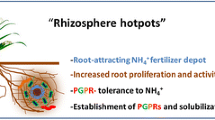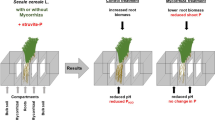Abstract
Background and Aims
To understand the bioavailability of phosphorus (P) under different conditions, it is important to consider the P uptake by plant roots and arbuscular mycorrhizal fungi (AMF) hyphae separately. This can be done with root study containers that separate soil into root– and hyphal–zone by a layer of nylon <30 μm mesh, which impedes root access to parts of the soil while enabling exploration by AMF (termed the hyphal zone). However, diffusion of P from the hyphal zone to the root zone can complicate the analysis of such experiments when a concentration gradient is created by a P–rich patch in the hyphal zone. This study tested whether a layer of tephra with high P sorption characteristics can be arranged to prevent P diffusion between the root zone and the hyphal zone.
Methods
A study of P sorption on tephra was conducted to determine the thickness of the tephra needed. Once this was established, the effectiveness of the “P diffusion break” in the modified root study container was tested. For this, Lotus pedunculatus cv. barsille was grown in the container having a low–P soil (Olsen P 4.3 mg kg−1) in the root zone and either low– or high–P soil (Olsen P 33.3 mg kg−1) in the hyphal zone.
Results
A 3–mm thick layer of tephra was shown to be adequate to prevent P diffusion for one year from the high–P soil to the low–P soil, as assessed by the absence of P accumulation in resin–P (< 5 mg kg−1) and total P in the tephra layer. Plant P uptake was increased by 1.9 mg pot−1 when AMF could access the high–P soil, resulting in an increase in plant yield by 56 %.
Conclusions
Given that (i) P diffusion across the tephra layer was prevented; (ii) roots were confined to the root zone; and (iii) AMF hyphae were detected in the tephra layer, the additional P uptake must have been through AMF acquisition. This experimental design can then be applied to study the influence of soil amendments (e.g. fertilizers, lime, biochar) either containing P or affecting P availability in soil to cause an increasing P transfer by AMF hyphae.





Similar content being viewed by others
Reference
Brundrett M (1994a) Chapter 3 Spores of glomalean fungi. In: Brundrett M, Melville L, Peterson L (Eds.) Practical methods in mycorrhiza research. Department of Biology, University of Waterloo
Brundrett M (1994b) Chapter 6 Clearing and staining mycorrhizal roots. In: Brundrett M, Melville L, Peterson L (Eds.) Practical methods in mycorrhiza research. Department of Biology, University of Waterloo
Curtin D, Syers JK (2001) Lime–Induced Changes in Indices of Soil Phosphate Availability. Soil Sci Soc Am J 65:147–152
Dane J, Hopmans J (2002) Water retention and storage. Methods of soil analysis. Part 4, 671–717
George TS, Gregory PJ, Robinson JS, Buresh RJ (2002) Changes in phosphorus concentrations and pH in the rhizosphere of some agroforestry and crop species. Plant Soil 246:65–73
Hanly JA, Hedley MJ, Horne DJ (2008) Evaluation of tephra for removing phosphorus from dairy farm drainage waters. Soil Research 46:542–551
Hedley MJ, Stewart JWB, Chauhan BS (1982) Changes in inorganic and organic soil phosphorus fractions induced by cultivation practices and by laboratory incubations. Soil Sci Soc Am J 46:970–976
Hedley M, Kirk G, Santos M (1994) Phosphorus efficiency and the forms of soil phosphorus utilized by upland rice cultivars. Plant Soil 158:53–62
Hewitt A, Dymond J (2013) Survey of New Zealand soil orders. Ecosystem services in New Zealand: conditions and trends 1(10):121–131
IUSS Working Group W (2006) World reference base for soil resources. World Soil Resour. Rep 103:70–75
Jansa J, Finlay R, Wallander H, Smith FA, Smith SE (2011) Chapter 6. Role of Mycorrhizal Symbioses in Phosphorus Cycling. In: Bünemann E, Oberson A, Frossard E (eds) Phosphorus in Action. Volume 26 of the series Soil Biology, pp. 137–168
Leake J, Johnson D, Donnelly D, Muckle G, Boddy L, Read D (2004) Networks of power and influence: the role of mycorrhizal mycelium in controlling plant communities and agroecosystem functioning. Can J Bot 82:1016–1045
Liesch AM (2010) Wastewater phosphorus removal by two different types of andesitic volcanic tephra. . J Nat Res Life Sci Edu 39:40–44
Marschner P, Rengel Z (2012) Nutrient availability in soil In: Marschner P, Marschner’s mineral nutrition of higher plants, 3rd ed. Academic press
McDowell R, Sharpley A, Brookes P, Poulton P (2001) Relationship between soil test phosphorus and phosphorus release to solution. Soil Sci 166:137–149
McKenzie H, Wallace H (1954) The Kjeldahl determination of nitrogen: A critical study of digestion conditions–temperature, catalyst, and oxidizing agent. Aust J Chem 7:55–70
Middleton KR, Toxopeus MRJ (1973) Diagnosis and measurement of multiple soil deficiencies by a subtractive technique. Plant Soil 38:219–226
Mizota C, Van Reeuwijk L (1989) Clay mineralogy and chemistry of soils formed in volcanic material in diverse climatic regions. ISM Monograph
Murphy J, Riley JP (1962) A modified single solution method for the determination of phosphate in natural waters. Anal Chim Acta 27:31–36
Neumann G, George TS, Plassard C (2009) Strategies and methods for studying the rhizosphere—the plant science toolbox. Plant Soil 321:431–456
Olsen SR, Cole CV, Watanabe FS (1954) Estimation of available phosphorus in soils by extraction with sodium bicarbonate. Circular / United states department of agriculture; no. 939. USDA, Washington
R Core Team (2015) R: A language and environment for statistical computing. R Foundation for Statistical Computing, Vienna, Austria URL https://www.R-project.org/
Ryden J, Syers J (1975) Use of tephra for the removal of dissolved inorganic phosphate from sewage effluent. N Z J Sci 18:3–16
Saggar S, Hedley MJ, White RE (1990) A simplified resin membrane technique for extracting phosphorus from soils. Nutr Cycl Agroecosyst 24:173–180
Saunders W (1959) Effect of phosphate topdressing on a soil from andesitic volcanic ash: Phosphate retention and pH. N Z J Agric Res 2:659–665
Schüepp H, Miller DD, Bodmer M (1987) A new technique for monitoring hyphal growth of vesicular–arbuscular mycorrhizal fungi through soil. Trans Br Mycol Soc 89:429–435
Schweiger P, Jakobsen I (2000) ) Laboratory and field methods for measurement of hyphal uptake of nutrients in soil. Plant Soil 226:237–244
Shen Q, Hedley M, Camps Arbestain M, Kirschbaum MUF (2016a) Can biochar increase the bioavailability of phosphorus? J Soil Sci Plant Nutr. doi:10.4067/S0718-95162016005000022
Shen Q, Kirschbaum MUF, Hedley MJ, Camps Arbestain M (2016b) Testing an alternative method for estimating the length of fungal hyphae using photomicrography and image processing. PLoS One 11(6):e0157017. doi:10.1371/journal.pone.0157017
Smith SE, Read DJ (2010) Mycorrhizal symbiosis. Access Online via Elsevier
Su Y, Zhang W, Xu F, Chen W (2015) Natural Volcanic Tephra for Phosphate Removal from Rural Micro–polluted Wastewater. Water Air Soil Pollution 226, 1–211
Suckling FET (1960) Productivity of pasture species on hill country. N Z J Agric Res 3:579–591
Thingstrup I, Kahiluoto H, Jakobsen I (2000) Phosphate transport by hyphae of field communities of arbuscular mycorrhizal fungi at two levels of P fertilization. Plant Soil 221:181–187
Trolove S, Hedley M, Caradus J, Mackay A (1996) Uptake of phosphorus from different sources by Lotus pedunculatus and three genotypes of Trifolium repens .1. Plant yield and phosphate efficiency. Soil Research 34:1015–1026
Trolove SN, Hedley MJ, Kirk GJD, Bolan NS, Loganathan P (2003) Progress in selected areas of rhizosphere research on P acquisition. Aust J Soil Res 41:471–499
Zoysa AKN, Loganathan P, Hedley MJ (1997) A technique for studying rhizosphere processes in tree crops: soil phosphorus depletion around camellia (Camellia japonica L.) roots. Plant Soil 190:253–265
Zoysa AKN, Loganathan P, Hedley MJ (1999) Phosphorus utilisation efficiency and depletion of phosphate fractions in the rhizosphere of three tea (Camellia sinensis L.) clones. Nutr Cycl Agroecosyst 53:189–201
Acknowledgments
The authors acknowledge financial support for Qinhua Shen from the New Zealand Biochar Research Centre. The authors are also deeply grateful to Dr. James Hanly for providing the tephra. We are also grateful for the technical support from Mr. Ian Furkert, Mr. Bob Toes, and Ms. Glenys Wallace; and Professor Surrinder Saggar and Associate Professor Brett Robinson for their suggestions. We thank Editor Professor Duncan D. Cameron and the anonymous reviewers for their helpful comments and suggestions.
Author information
Authors and Affiliations
Corresponding author
Additional information
Responsible Editor: Duncan D. Cameron.
Rights and permissions
About this article
Cite this article
Shen, Q., Hedley, M., Arbestain, M.C. et al. Tephra is an effective P diffusion barrier in root exclusion experiments. Plant Soil 410, 51–61 (2017). https://doi.org/10.1007/s11104-016-2980-4
Received:
Accepted:
Published:
Issue Date:
DOI: https://doi.org/10.1007/s11104-016-2980-4




